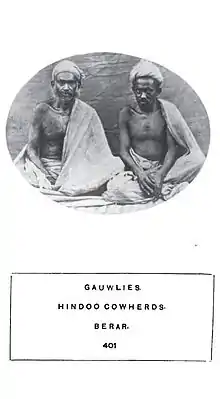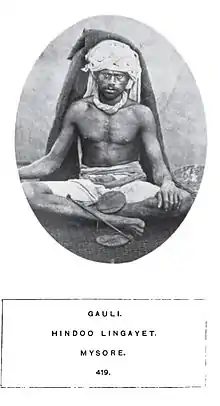Gavli
Gavli or Gawli is a cattle-herding caste found in the Indian states of Maharashtra, Goa and Karnataka.[1] They are distributed all over Maharashtra. Gavli as a community refers to either cowherds or sellers of milk and its products or both. Although Enthoven classifies Gavlis into 17 sub-groups, he notes that they have nothing in common except a common occupation. While some of them are sub-castes of distinct castes like Dhangar Gavlis, Golla Gavlis, Kuruba Gavlis and Lingayat Gavlis, others are localized castes of their respective regions.[2][3][4] Alongwith Dhangars and Maratha Kunbis, Gavlis are considered one of the allied castes of Maratha caste and have been included in the Maratha Regiment in the past.[5][6]

Sub-groups
While M. S. A. Rao classifies Gavli caste of Konkan region into Dabholis and Chevlis,[2][7] Siraj-ul-Hassan classifies Gavlis in the Nizam's former Hyderabad state, i.e., Marathwada region, into two divisions, namely Nagarkar and Vajarkar.[8][4] On the other hand, castes like Dhangar Gavlis, Golla Gavlis, Kuruba Gavlis and Lingayat Gavlis are sub-castes of Dhangars, Gollas, Kurubas and Lingayats respectively.[2][3] Dabholis and Chevlis are localized castes of their respective regions. Gavlis are classified as Other Backward Class in Indian system of reservation.[9]

Lingayat Gavli
They are a sub-group of Lingayats and speak Kannada amongst themselves. They follow Veerashaivism as a religion.[2]
Dabholis and Chevlis
They are a localized caste of Ratnagiri and Colaba region. They claim higher status than all other Gavli sub-groups of Maharashtra. Vithal Krishnaji Khedkar belonged to the Gavli caste of Ratnagiri. He was one of the founding members of the All-India Yadav Mahasabha which was inaugurated in 1924 at Allahabad. He protested against the fact that the Southborough Committee did not consider Yadav Gavlis as Marathas.[10][6]
Nagarkar and Vajarkar
They are found in the Marathwada region and in some parts of Telangana. Their division into two groups is based on their habitats and modes of life. Nagarkar are those Gavlis who have settled as a pastoralist caste on the edges of villages or towns (nagar). Vajarkar Gavlis are pastoralists who lived in forested areas with better grazing, similar to Dhangar Gavlis who live in the Western Ghats. Vajar is derived from Sanskrit vraja, which means cattle-shed. Both Nagarkars and Vajarkars have no traditions and cannot give any account of their origin, nor of their former settlement. It is possible that they may be an offshoot of Lingayat community. Like other Lingayats, they wear a lingam round their necks and worship it daily with offerings of flowers and food before they dine. They rank higher, socially, than the Maratha Kunbis and are equal to those groups of the Lingayats who have undergone Diksha. They do not eat animal food. They worship Khandoba, Nagoba, Bhavani of Tuljapur, Ganesha and other major Hindu gods.[11][4]
Dhangar Gavli
Dhangar Gavli, referred as Gavli or Gouly, is a sub-caste of Dhangar caste cluster. They are found in southern Maharashtra, Goa and northern Karnataka. Among Dhangars they are also referred as Dange or Mhaske. They are cattle/buffalo herding pastoral people and practice shifting cultivation. They primarily kept buffaloes because of their ability to defend themselves against panthers and tigers in the traditional habitat as buffaloes are more heavily built than cattle. Hatkars and Gavlis used to be a single group of people in the past with their traditional occupation as cattle herding. Gavlis trace their migration to western ghats from Chaphal via Nanegaon, Kelawali, Irewadi and finally to Sadawaghpur. The migration is believed to have occurred around the 15th century AD. Their subsistence has been primarily on ragi, jowar, buttermilk and some lentils and dried fish. Starting in the 1960s, Gavlis became major suppliers of milk in Pune, Kolhapur and other major regions around their settlement.[12][1]
In Goa under colonialism, the community shied away from the rest of society as they wanted to escape the grazing tax and ban on Kumeri introduced by the Portuguese Empire. Gavli leaders claim that they had fled to remote hilly and forested areas to avoid religious persecution. They were not part of the Comunidade anywhere in Goa. It is claimed that throughout the Portuguese rule in Goa they were so insulated that not a single Gavli got converted to Christianity.[13][14]
Mhasoba,[15] Vitthal, Padubai,[16] Ambabai,[17] Banai,[18] Kanhoba (Krishna)[19] and Yelubai (Yellamma)[20] are the major deities of Gavlis. According to some traditions, Banai, wife of Khandoba is Gavli.[18] They consider Vitthal as a Kannadiga Gavli and not Krishna from Dwarka. Vitthal is worshiped alongside his wife Padubai.[21]
Assimilation into Yadav community
Vithal Krishnaji Khedkar, a Gavli from Maharashtra, alongwith Ahir leaders of North India founded All-India Yadav Mahasabha (AIYM) in 1924 to promote Sanskritization of Gavli and Ahir community. AIYM militated cowherds, herdsmen and milksellers all over India to call themselves Yadav, adopt the last name "Yadav", and practice vegetarianism and teetotalism.[22] They claimed that they have descended from the Yadu dynasty of the Puranas, hence the term Yadav, through the Abhira tribe. Lord Krishna, a cowherd, was the hero-god of Abhiras.[23] Moreover, Historians such as P. M. Chandorkar has used epigraphical evidence to argue that Ahirs and Gavlis are representative of the ancient Yadavas and Abhiras mentioned in Sanskrit works.[24]
Relationship with Deccan Yadavas

The word Yāḍava is formed from yāḍu and yāḍu means Sheep or Goat in Tamil. In the Deccan region, the original worshippers of pastoralist god Vitthal – the Gollas and Kurubas of Andhra Pradesh and Karnataka and Gawlis and Dhangars of Maharashtra, especially southern Maharashtra – are continued to be called "Yāḍavas". Similar to them, several royal families who enhanced the magnificence of Vitthal's worship are called "Yādavas". The difference here is "ḍ" and "d", where "Yāḍavas" represents Dravidian version and "Yādavas" is the Sanskritized version of it. Linguistically this difference is subtle, and so "Yāḍavas" became "Yādavas", i.e., most of these royal dynasties arose from pastoralist groups and took the name Yādava in order to raise their status by connecting themselves with Krishna's clan, Yadu dynasty of the Puranas. They elevated their traditional pastoralist god (Vitthal) into a form of Vishnu-Krishna and accorded high prestige to his worship.[25]
The Seuna Yadava dynasty, which ruled present-day Maharashtra and north Karnataka, arose out of the valorous deeds of Dridhaprahara, founder of the dynasty, who protected cattle. According to the traditional sources, Devagiri, the capital of Seuna Yadavas, was founded by a king who was a Dhangar Gavli.[4][26] The idea that the Seunas were a Gavli dynasty survives to this day in folk traditions of the Nashik-Khandesh area, where the they are traditionally called "Gavli Kings".[27][28] During the reign of Seuna Yadavas and their rival Hoysala Yadavas, the temple of Vitthal at Pandharpur, under their purview, grew from a small pastoral deity site to a major temple complex.[29]
Notable people
- Arun Gawli (born 1955), Indian politician
- Shekhar Gawli (1975–2020), Indian cricketer
- Vandana Gawli, Indian politician
References
- Malhotra, K. C. (March 1982). "Ecology of a pastoral caste: Gavli Dhangars of peninsular India" (PDF). Human Ecology. 10 (1): 107–143. doi:10.1007/BF01531107. S2CID 154253698.
- Rao (1979), p. 129.
- Enthoven (1990), p. 368.
- Feldhaus (1989), p. 101.
- Constable, Philip (2001). "The Marginalization of a Dalit Martial Race in Late Nineteenth- and Early Twentieth-Century Western India". The Journal of Asian Studies. 60 (2): 439–478. doi:10.2307/2659700. JSTOR 2659700. PMID 18268829. Retrieved 2020-11-28.
While the bulk of Shivaji's men were naturally Marathas, they included not only the allied castes of Dhangars and Gowalas, shepherds and herdsmen, but many who had no claim to kinship. For example Shivaji's famous infantry was composed largely of Bhandaris and Kolis. The Ramoshis... who afterwards formed the infantry of Haidar and Tipu in Mysore, were relied an for the capture of the hill forts, while the outcaste Mahars and Mangs served in his artillery, and in the garrisons of these forts - Patrick Cadell
- Jaffrelot (2003), p. 163.
- Rao (1972), p. 76.
- Hassan (1989), p. 196.
- Central Commission for Backward Classes (2020-10-20). Central List of OBCs Maharashtra (Report). Archived from the original on 10 November 2020.
- Rao (1972), p. 78.
- Hassan (1989), p. 196-199.
- Lukacs (2001), p. 443-450.
- Kerkar, Rajendra (2019-01-11). "Tribal tag for Dhangars long pending". Goa. Archived from the original on 24 October 2020.
- Herald, Team (2013-10-24). "Dhangars-Gouly treated like outsiders, says report". Goa. Archived from the original on 24 October 2020.
- Feldhaus (1989), p. 25,26.
- Feldhaus (1989), p. 47,167.
- Feldhaus (1989), p. 46.
- Feldhaus (1989), p. 60.
- Feldhaus (1989), p. 167.
- Feldhaus (1989), p. 56.
- Feldhaus (1989), p. 47.
- Rao (1979), p. 141.
- Jaffrelot (2003), p. 189,194-196.
- Guha (2006), p. 47.
- Dhere (2011), p. 234,238,241.
- Wink (2001), p. 231.
- Dhere (2011), p. 237,246,247.
- Dhavalikar (2014), p. 274.
- Novetzke (2016), p. 93.
Bibliography
- Guha, Sumit (2006). Environment and Ethnicity in India, 1200-1991. University of Cambridge. ISBN 978-0-521-02870-7.
- Rao, M. S. A. (1979). Social movements and social transformation: a study of two backward classes movements in India. Delhi: Macmillan. ISBN 9780333902554.
- Bayly, Susan (2001). Caste, Society and Politics in India from the Eighteenth Century to the Modern Age. Cambridge University Press. ISBN 978-0-521-79842-6.
- Jaffrelot, Christophe (2003). India's Silent Revolution: The Rise of the Lower Castes in North India. C. Hurst & Co. Publishers. ISBN 978-1-85065-670-8.
- Dhere, Ramchandra (2011). Rise of a Folk God: Vitthal of Pandharpur South Asia Research. Oxford University Press, 2011. ISBN 9780199777648.
- Hassan, Syed Siraj ul (1989). The castes and tribes of H.E.H. the Nizam's dominions. Asian Educational Services. ISBN 978-81-206-0488-9. Retrieved 2011-07-25.
- Enthoven, R. E. (1990). The Tribes and Castes of Bombay, Vol 1. Asian Educational Services. ISBN 9788120606302.
- Dhavalikar, Madhukar (2014). Socio-economic Archaeology of India. Archaeological Survey of India, 2014.
- Rao, M. S. A. (1972). Tradition, rationality, and change: essays in sociology of economic development and social change. Popular Prakashan.
- Novetzke, Christian Lee (2016). The Quotidian Revolution: Vernacularization, Religion, and the Premodern Public Sphere in India. Columbia University Press. doi:10.7312/nove17580. ISBN 9780231542418.
- Lukacs, John (2001). The People of South Asia: The Biological Anthropology of India, Pakistan, and Nepal. Springer. ISBN 9781489950031.
- Feldhaus, Anne (1989). Sontheimer, Gunther-Dietz (ed.). Pastoral Deities in Western India. Oxford University Press. ISBN 9780195055009.
- Wink, Andre (2001). Nomads in the Sedentary World. Routledge (Taylor and Francis Group). ISBN 9780203037201.
